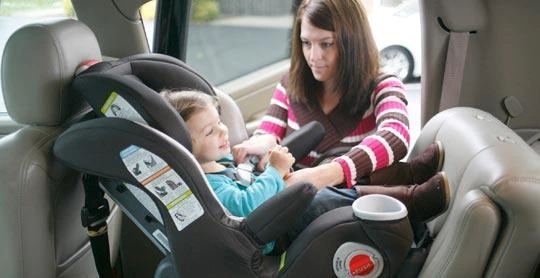National Child Heatstroke Prevention Day- 4/16/19

Child Vehicular Heatstroke
Those are not three words that should every have to be seen together. As a parent, the very phrase of child vehicular heatstroke is so appalling to think about, we immediately have to comfort ourselves into believing it could never happen to us. The death of a child left in a hot car is so disturbing that we often react to it with disbelief and criticism. It is a nightmare thought for a parent who already spends most of our days worrying incessantly about our children’s safety, growth, education, social development and on and on.
One of our primary functions as parents is to protect our children. Protecting our children is such an innate concept that the very idea that our children could be harmed or killed as a direct result of our actions is so offensive, many cannot even process it. Thus, when one of these heatstroke deaths happens to a child and it is in the news, we react in many different and sometimes unflattering ways. If we are honest with ourselves, the concept is so horrific that it is extremely painful to try to be emphatic or put yourself in that parent’s shoes. Worse than burying our heads in the sand, is the temptation to make comments about the parent’s marital status or parenting skills. In the vast majority of these horrific incidents, those parents never thought it would happen to them. First, we need to understand how these horrible events occur so that we can avoid these tragedies occurring. Second, we may want to think more emphatically about these parents involved in these tragedies. This article is not to argue criminalization or innocence of any one incident but to better understand how this tragic trend started and what each of us can do to avoid it.
KidsAndCars.org
When you actually look at the individual incidents of these heatstroke deaths, there are commonalities in these tragedies. One of those commonalities is just about every one of these parents were considered very good parents. In the last 10-15 years, there has been a lot more research of these incidents with the explicit goal of reducing or wiping out these tragedies altogether. I would encourage you to visit KidsAndCars.org as they have so many helpful tools to keep your children safe in and around vehicles. In 2018, 51 children that died due to being trapped inside vehicles. This is the highest number of deaths in one year. What I love about KidsAndCars.org is that they bring awareness but they also come up with solutions and lobby car manufacturers to make cars with more safety features. KidsAndCars.org is an organization of awareness and action.
How Does this Happen?
Psychology Professor David Diamond from the University of South Florida has been studying this horrible phenomenon for over a decade and served as an expert in many similar cases. He offered an explanation of his findings in Medicine, Science and the Law, titled Why the Human Brain Allows Loving Caretakers to Leave a Child to Die in a Hot Car. He describes the psychological and neural basis of how responsible people can make such fatal errors.
The hope is that by understanding the way our brains work, we can implement strategies to help each of us overcome these errors. Diamond explains how the brain can fail to remember to do something in the future (prospective memory). An example of prospective memory is remembering to call a friend after lunch or stop at the grocery store on the way home. Diamond describes how the frontal and parietal cortices allow us to use stored information to make a plan and then to execute that plan in the future. The hippocampus is essential for consciously remembering to retrieve the memory and that the task was completed. The basal ganglia enables us to go into an autopilot mode in such situations as a well-traveled route to and from work, but in the process we may lose awareness of the plan to take the child to daycare. Diamond says that when someone goes into autopilot mode for habitual behavior such as getting ready to go to work and driving to work on a typical day, a parent can lose awareness of the child in the car. Especially, if the daily routine has been altered. For example, maybe Dad drops the baby off at the babysitter on his way to work, but on Wednesday, Mom was doing that task as Dad had an early meeting. Typically, Mom may not do this task in this particular family so it’s not part of her routine. Competing factors can cause the execution of a prospective memory plan to fail. Those competing factors can be stress, a disrupting phone call and sleep deprivation. I think most parents are sleep deprived and we can all relate to these competing factors.
Thus, knowing our brains and prospective memory can fail us, we can set up layers of reminders. Clearly, if the baby is crying during the whole commute, you remember they are in the car seat. Putting reminders in your car is not a sign of weakness or bad parenting–quite the contrary.
Why Not Utilize Safety Reminders?
If you have children, you already set up all kinds of safety reminders in your home whether it is choosing child safety locks for drawers and cabinets, covers for sockets or fencing and layering for your pool. Thus, why wouldn’t you use any and all safety reminders in and around your car?
KidsAndCars.org shares safety information and attempts to assist parents in providing safety layers and encouraging auto manufacturers to be a part of the solution. Hot car deaths of children happen to all kinds of parents no matter race, wealth or occupation.. Furthermore, it happens the same to moms and dads, equally. The Washington Post Magazine published a heart wrenching article of several parents true stories of inadvertently leaving their child in a hot car and the resulting court cases. It discussed the fatal distraction of great parents that led to the tragic deaths of their child. This phenomena developed in the last couple of decades after experts determined in the 1990’s that passenger-side airbags caused the front passenger seat to be a fatal position for a child seat. (This change in the 90’s explains why it never happened to your parents). Thus, parents moved their children to the back seat in either rear-facing or front-facing car seats depending on age and size. Since then, there have been about 10-25 death per year beginning in the spring and through out the summer.
In each of these scenarios, each has it’s own facts; but the moment the parent realizes what has happened is very similar. The moment of realization and discovery is always horrific and grotesque. The Washington Post discusses the opinions on whether or not these tragedies should be criminally prosecuted. A parent and Fulbright scholar, Mark Warshauer said there is really no word for the event. An “accident” makes it sound like it was unavoidable, however an “incident” trivializes it. Warshauer knows of what he speaks. One summer day he returned to his office from lunch and discovered the parking lot was full of emergency workers and saw a police officer busting out his windshield. Then, he remembered he had forgotten to take his son to daycare. His son died and for many months, Warshauer considered suicide. Later, he was able to articulate the experience. These tragedies happened to every kind of parent. It happens to police officers, dentist, paralegals, doctors, warehouse workers–every type of person.
Is It a Crime?
In about 40% of these incidents, parents or caregivers are charged. Often, they are not criminally convicted. Often, these parents will say there is no criminal conviction worse than the consequences of losing their child. My point in this article is not to determine whether or not these parents should be charged. When any prosecutor examines these incidents, they have to consider and prove “intent”. The point of this article is to raise awareness in the hopes of better educating other parents.
The way human beings react to these news stories actually tell us a great deal about ourselves. When you hear of these tragedies, often times the initial reaction is disbelief and shock that the parent was too distracted by their difficult marriage, work demands, online life or any myriad of other criticisms. It is frequently easier as a parent to dismiss or judge these situations to make them seem far more improbable to “good parents” such as ourselves. But, clearly, these tragedies can happen to anyone.
So, whether or not these should be criminally prosecuted come down to the individual situation, the prosecutors and the element of “intent”. Often, (especially in our online age where “comments” are aplenty)–individuals make many judgmental statements. Often these individuals pass judgment and criticize to avoid actually facing the fact that it can happen to any of us.
Now that We Understand How it Happens, Take Action
My point is not to argue whether these parents should be criminally convicted, but my point is that each of us need to simply try to understand how these tragedies occur so we can all avoid them. Putting our metaphorical heads in the sand and pretending that this nightmare could never happen to us is one of the best ways that it will happen.
Child safety is a communities issue as well. In the last several years, many states have enacted laws so that if you see a child left in a car, not only can you call 911, you may be completely in your rights to break a window to rescue a child. Whether or not it is legal to break a window, you have to always be on the lookout for children left in cars. Too often, children have died in hot cars because a passerby didn’t want to get involved. Due to the national awareness of these horrible deaths, I believe it would be challenging to find anyone who would fault a Good Samaritan for calling 911. In the vast majority of stations, the parents will thank you as well.
Let’s learn from these tragedies. Visit KidsAndCars.org for safety tips to assist you in avoiding forgetting your child is in the car.
Tips:
Put your cell phone under or near your child. You will not forget your cell phone or certainly you will notice you do not have your cell phone within minutes.
Put a reminder such as a stuffed toy in the passenger side seat when your child is in the car. Many parents then put the stuffed toy in the car seat while their child is not in the seat, so they have a visual reminder
Put a reminder on your phone. You can set these reminders the night before or 20 minutes before!
Develop a contact/follow up system with you child care provider, so that if the child is not dropped off, they will follow up with the parents.
Child Safety Seats-They Are a Must
Be sure that your child safety seat is properly installed according to the manufacturer’s instructions. Various community organizations will voluntarily check to be sure your child seat is installed properly. Car seats make a huge difference when it comes to child injuries in a motor vehicle crash.
Call us toll free 1.800.685.3302 or locally 314.276.1681
Contact Us Today
The Cagle Law Firm serves accident and injury clients throughout St. Louis and the greater St. Louis metropolitan area, including the eastern Missouri and southern Illinois communities. If you or a loved one needs legal assistance with your personal injury case, call The Cagle Law Firm at (314) 276-1681 or use our online contact form to schedule a free consultation.
Areas Served
The Cagle Law Firm – Missouri
The Cagle Law Firm – Illinois
The Cagle Law Firm – Kentucky
CONTACT THE CAGLE LAW FIRM TODAY
Schedule your FREE CONSULTATION today by contacting us at (314) 276-1681 or by sending us an email through the online contact form.
Contact Us Today
Request Your Free Consultation
Fields marked with an * are required
Copyright © 2024 The Cagle Law Firm. All rights reserved.





